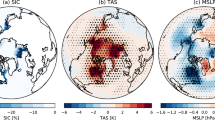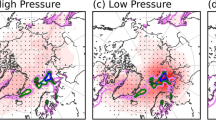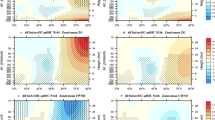Abstract
Over the past decade, severe winters occurred frequently in mid-latitude Eurasia1,2, despite increasing global- and annual-mean surface air temperatures3. Observations suggest that these cold Eurasian winters could have been instigated by Arctic sea-ice decline2,4, through excitation of circulation anomalies similar to the Arctic Oscillation5. In climate simulations, however, a robust atmospheric response to sea-ice decline has not been found, perhaps owing to energetic internal fluctuations in the atmospheric circulation6. Here we use a 100-member ensemble of simulations with an atmospheric general circulation model driven by observation-based sea-ice concentration anomalies to show that as a result of sea-ice reduction in the Barents–Kara Sea, the probability of severe winters has more than doubled in central Eurasia. In our simulations, the atmospheric response to sea-ice decline is approximately independent of the Arctic Oscillation. Both reanalysis data and our simulations suggest that sea-ice decline leads to more frequent Eurasian blocking situations, which in turn favour cold-air advection to Eurasia and hence severe winters. Based on a further analysis of simulations from 22 climate models we conclude that the sea-ice-driven cold winters are unlikely to dominate in a warming future climate, although uncertainty remains, due in part to an insufficient ensemble size.
This is a preview of subscription content, access via your institution
Access options
Subscribe to this journal
Receive 12 print issues and online access
$259.00 per year
only $21.58 per issue
Buy this article
- Purchase on Springer Link
- Instant access to full article PDF
Prices may be subject to local taxes which are calculated during checkout




Similar content being viewed by others
Change history
16 January 2015
We would like to draw attention to the colour scales in Fig. 1. Specifically, we used different colour scales for the panels showing reanalysis data (a,c) and those showing model ensembles (b,d). In a and b only the negative parts of the colour scale (blue shades) differ, by a factor of four. In c and d the entire colour scale is different. This does not imply that the model underestimates observed atmospheric responses to the Arctic sea-ice reduction: owing to small sample size, a and c contain a considerable signal associated with the Arctic Oscillation, which accounts for about half of negative temperature anomalies over central Eurasia (Supplementary Infomation 1, Supplementary Fig. 5); the Arctic Oscillation signal is largely eliminated from the model ensemble mean (Supplementary Fig. 6). In contrast, central Eurasian temperature anomalies associated with the WACE pattern—the robust circulation response to sea-ice loss—were in good agreement between observations (–0.8 K) and model ensemble mean (–0.6 K) (Supplementary Figs 5,6).
References
Cohen, J. L., Furtado, J. C., Barlow, M. A., Alexeev, V. A. & Cherry, J. E. Arctic warming, increasing snow cover and widespread boreal winter cooling. Environ. Res. Lett. 7, 014007 (2012).
Liu, J., Curry, J. A., Wang, H., Song, M. & Horton, R. M. Impact of declining Arctic sea ice on winter snowfall. Proc. Natl Acad. Sci. USA 109, 4074–4079 (2012).
IPCC Summary for Policymakers, in Climate Change 2013: The Physical Science Basis (eds Stocker, T. F. et al.) 1–30 (Cambridge Univ. Press, 2013).
Tang, Q., Zhang, X., Yang, X. & Francis, J. A. Cold winter extremes in northern continents linked to Arctic sea ice loss. Environ. Res. Lett. 8, 014036 (2013).
Cohen, J. et al. Recent Arctic amplification and extreme mid-latitude weather. Nature Geosci. 7, 627–637 (2014).
Screen, J. A., Deser, C., Simmonds, I. & Tomas, R. Atmospheric impacts of Arctic sea-ice loss,1979–2009: Separating forced change from atmospheric internal variability. Clim. Dyn. 43, 333–344 (2013).
Overland, J. E., Wood, K. R. & Wang, M. Warm Arctic-cold continents: Climate impacts of the newly open Arctic Sea. Polar. Res. 30, 15787 (2011).
Comiso, J. C., Parkinson, C. L., Gersten, R. & Stock, L. Accelerated decline in the Arctic sea ice cover. Geophys. Res. Lett. 35, L01703 (2008).
Screen, J. A. & Simmonds, I. The central role of diminishing sea ice in recent Arctic temperature amplification. Nature 464, 1334–1337 (2010).
Serreze, M. C. & Barry, R. G. Processes and impacts of Arctic amplification: A research synthesis. Glob. Planet. Change 77, 85–96 (2011).
Hopsch, S., Cohen, J. & Dethloff, K. Analysis of a link between fall Arctic sea ice concentration and atmospheric patterns in the following winter. Tellus A 64, 18624 (2012).
Inoue, J., Hori, M. E. & Takaya, K. The role of Barents sea ice in the wintertime cyclone track and emergence of a Warm-Arctic Cold-Siberian anomaly. J. Clim. 25, 2561–2568 (2012).
Honda, M., Inoue, J. & Yamane, S. Influence of low Arctic sea-ice minima on anomalously cold Eurasian winters. Geophys. Res. Lett. 36, L08707 (2009).
Petoukhov, V. & Semenov, V. A. A link between reduced Barents–Kara sea ice and cold winter extremes over northern continents. J. Geophys. Res. 115, D21111 (2010).
Screen, J. A., Simmonds, I., Deser, C. & Tomas, R. The atmospheric response to three decades of observed Arctic sea ice loss. J. Clim. 26, 1230–1248 (2013).
Peings, Y. & Magnusdottir, G. Response of the wintertime Northern Hemisphere atmospheric circulation to current and projected Arctic sea ice decline: A numerical study with CAM5. J. Clim. 27, 244–264 (2014).
Sakamoto, T. T. et al. MIROC4h: A new high-resolution atmosphere-ocean coupled general circulation model. J. Meteorol. Soc. Jpn 90, 325–359 (2012).
Palmer, T. N. A nonlinear dynamical perspective on climate prediction. J. Clim. 12, 575–591 (1999).
Corti, S., Molteni, F. & Palmer, T. N. Signature of recent climate change in frequencies of natural atmospheric circulation regimes. Nature 398, 799–802 (1999).
Magnusdottir, G., Deser, C. & Saravanan, R. The effects of North Atlantic SST and sea ice anomalies on the winter circulation in CCM3. Part I: Main features and storm track characteristics of the response. J. Clim. 17, 857–876 (2004).
Deser, C., Magnusdottir, G., Saravanan, R. & Phillips, A. The effects of North Atlantic SST and sea ice anomalies on the winter circulation in CCM3. Part II: Direct and indirect components of the response. J. Clim. 17, 877–889 (2004).
Alexander, M. A. et al. The atmospheric response to realistic Arctic sea ice anomalies in an AGCM during winter. J. Clim. 17, 890–905 (2004).
Bader, J. et al. A review on Northern Hemisphere sea-ice, storminess and the North Atlantic oscillation: Observations and projected changes. Atmos. Res. 101, 809–834 (2011).
Taylor, K. E., Stouffer, R. J. & Meehl, G. A. An overview of CMIP5 and the experiment design. Bull. Am. Meteorol. Soc. 93, 485–498 (2012).
Christensen, J. H. et al. in Climate Change 2013: The Physical Science Basis (eds Stocker, T. F. et al.) 1217–1308 (IPCC, Cambridge Univ. Press, 2013).
Rayner, N. A. et al. Global analyses of sea surface temperature, sea ice, and night marine air temperature since the late nineteenth century. J. Geophys. Res. 108, D144407 (2003).
Hansen, J., Ruedy, R., Sato, M. & Lo, K. Global surface temperature change. Rev. Geophys. 48, RG4004 (2010).
Dee, D. P. et al. The ERA-Interim reanalysis: Configuration and performance of the data assimilation system. Q. J. R. Meteorol. Soc. 137, 553–597 (2011).
Kushnir, Y. & Wallace, J. M. Low-frequency variability in the Northern Hemisphere winter: Geographical distribution, structure and time-scale dependence. J. Atmos. Sci. 46, 3122–3142 (1989).
D’Andrea, F. et al. Northern Hemisphere atmospheric blocking as simulated by 15 atmospheric general circulation models in the period 1979–1988. Clim. Dyn. 14, 385–407 (1998).
Acknowledgements
We acknowledge the modelling groups, the PCMDI and the WCRP’s WGCM for their efforts in making the CMIP5 multi-model data set available. We thank M. Yoshimori and M. Honda for helpful discussion. This work was supported by the Grant-in-Aid 24241009 and the Program for Risk Information on Climate Change (SOUSEI program) from the Ministry of Education, Culture, Sports, Science and Technology (MEXT), Japan.
Author information
Authors and Affiliations
Contributions
M.W. and M.M. designed the research. M.M. performed the numerical experiments and analysis. M.M. and M.W. wrote the paper. All authors discussed the results and commented on the manuscript.
Corresponding author
Ethics declarations
Competing interests
The authors declare no competing financial interests.
Supplementary information
Supplementary Information
Supplementary Information (PDF 3266 kb)
Rights and permissions
About this article
Cite this article
Mori, M., Watanabe, M., Shiogama, H. et al. Robust Arctic sea-ice influence on the frequent Eurasian cold winters in past decades. Nature Geosci 7, 869–873 (2014). https://doi.org/10.1038/ngeo2277
Received:
Accepted:
Published:
Issue Date:
DOI: https://doi.org/10.1038/ngeo2277
This article is cited by
-
Response of winter climate and extreme weather to projected Arctic sea-ice loss in very large-ensemble climate model simulations
npj Climate and Atmospheric Science (2024)
-
Differing roles of North Atlantic oceanic and atmospheric transports in the winter Eurasian Arctic sea-ice interannual-to-decadal variability
npj Climate and Atmospheric Science (2024)
-
Why Are Arctic Sea Ice Concentration in September and Its Interannual Variability Well Predicted over the Barents–East Siberian Seas by CFSv2?
Journal of Meteorological Research (2024)
-
The warm Arctic-cold north american pattern in CanESM5 large ensemble simulations: Eurasian influence and uncertainty due to internal variability
Climate Dynamics (2024)
-
Relationship between systematic temperature bias and East Asian winter monsoon in CORDEX East Asia phase II experiments
Climate Dynamics (2024)



